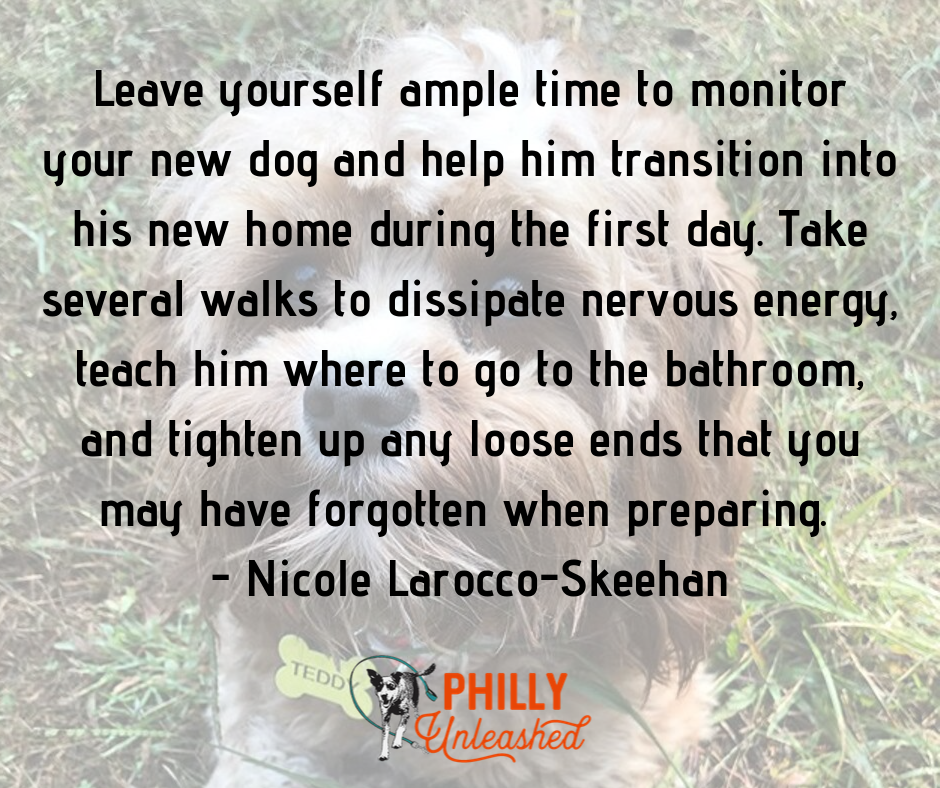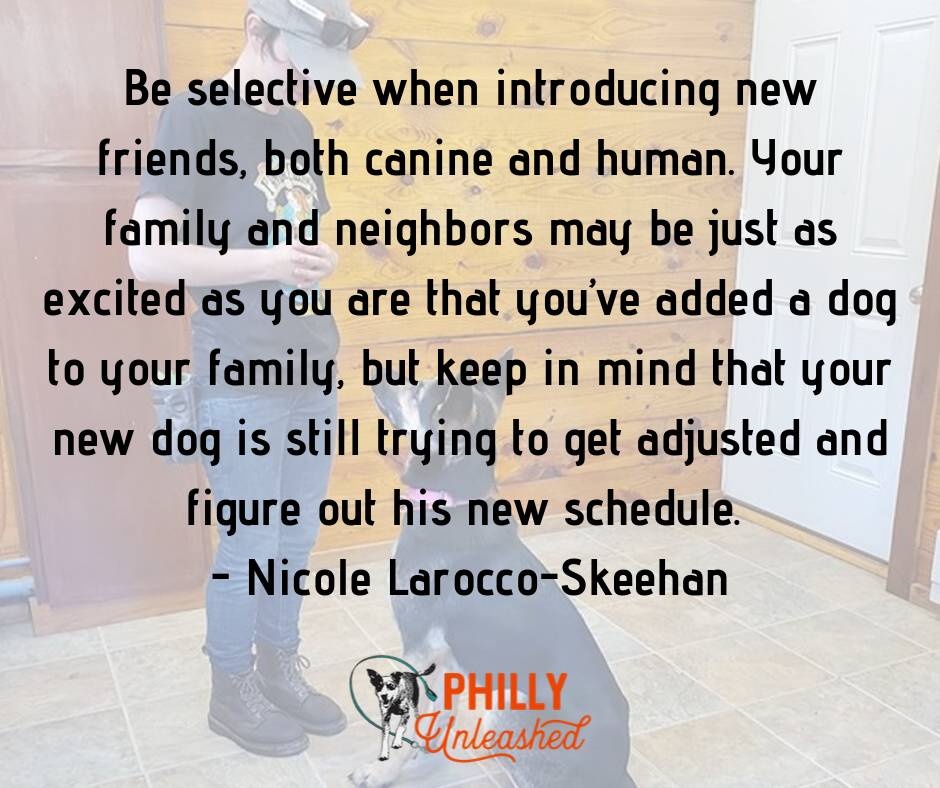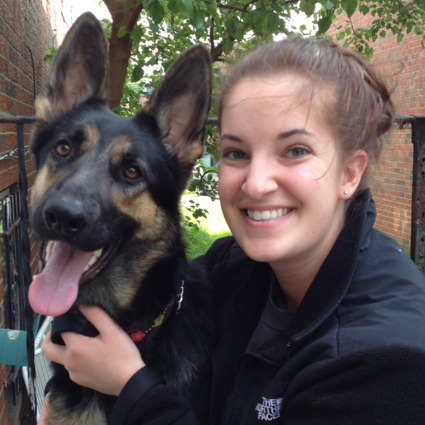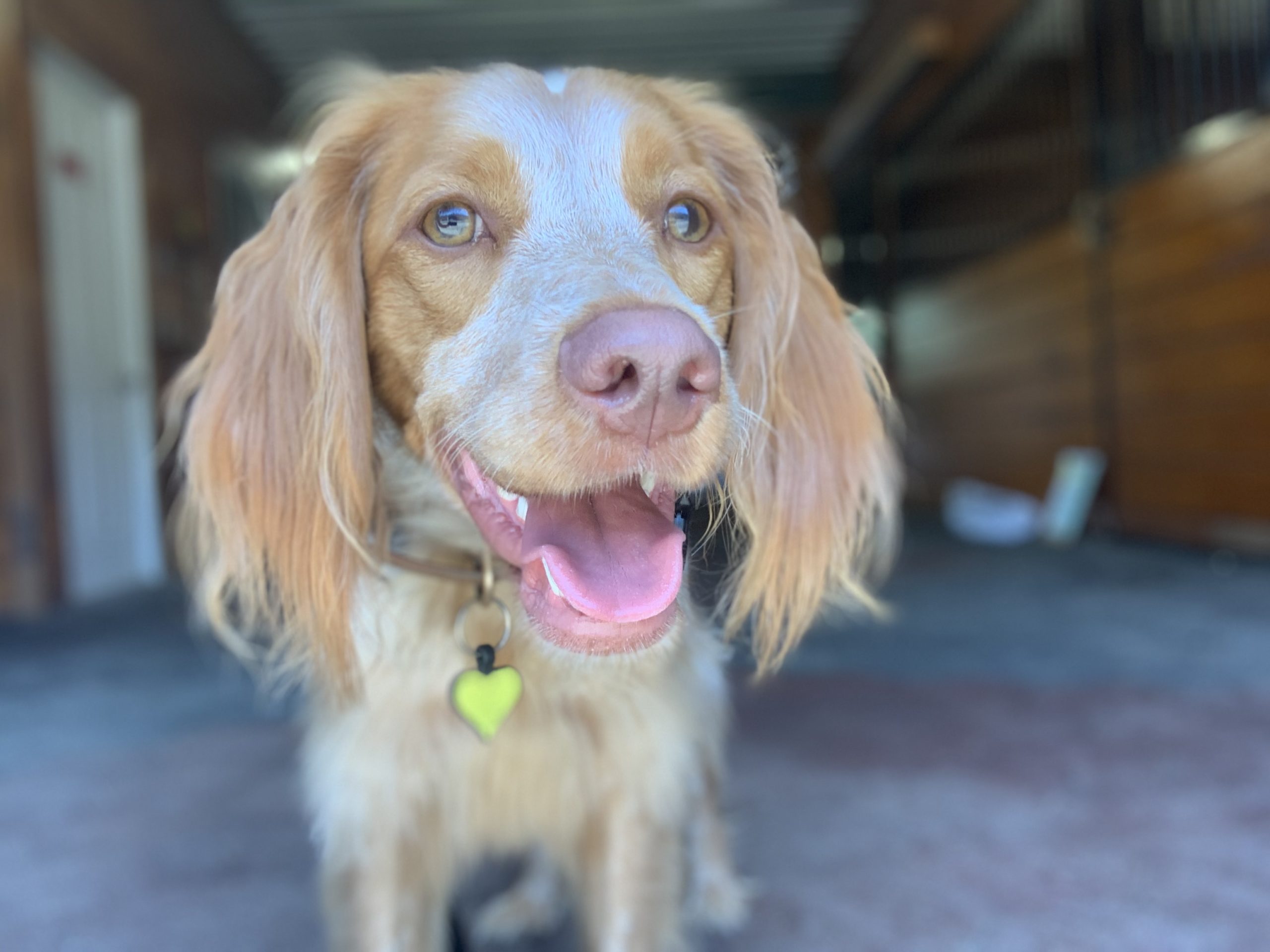By Nicole Larocco-Skeehan, CPDT-KA
The only thing predictable when bringing home a new dog is that everyone in the house, dog included, will be under a lot of stress that first day.
There’s often discussion of buyer’s remorse when it comes to a car or a home. There are expectations, things that go wrong, dreams squashed.
I’ve put together a timeline to assist when bringing a new four-legged family member into your home. Here’s what to expect.
First 24 Hours:
Perhaps your new dog was cooped up in a small kennel with little mental or physical activity for days, weeks, even months before you picked him up. Perhaps he’d just been through surgery or he is on medication because he’s not feeling well. Maybe your new dog has never even lived in a house before, or worse, he was just kicked out of his happy home for chewing up the furniture.
We can speculate, but the only thing that is predictable when you rescue a new dog is that everyone in your house (the new dog included) will be under a lot of stress that first day. Behaviors may be all over the map within the first 24 hours of living with your new dog. Your dog could be shut down and not want to interact with members of the household. He may be hyperstimulated and run around with little regard to personal space or possessions. Perhaps your new dog will take the opportunity to mark his new territory, or he may be so nervous that he has an accident in the house. In extreme cases, aggression or anxiety may present.
Tip #1: Dog Proof Your Home Before Dashing Out the Door
Purchase the necessities before picking up your new dog if possible. These include a collar, leash, crate, chew toys (both the edible and the indestructible variety), training treats, food, and plenty of poop bags and clean up items. Tidy your home and pick up anything in your house that is at the eye-level of a curious dog. This includes knick-knacks and breakables, magazines, candy or snacks left on tabletops or counters, children’s toys, and pillows. All of these items tend to be particularly exciting to a new dog.
Tip #2: Take the Day Off of Work and Don’t Make Plans
Leave yourself ample time to monitor your new dog and help him transition into his new home during the first day. This includes taking several walks to dissipate nervous or excited energy, teaching him where to go to the bathroom, and tightening up any loose ends that you may have forgotten when preparing your home. This is not the time to catch a movie with your friends or leave your new dog in a crate while you attend your daughter’s all-day soccer tournament. Just take the day to get the relationship between you and your new dog off on the right foot.

Days 2-7:
The first week at home is an adjustment period for both you and your new dog. Residual stress is still present in dogs throughout the first week that they live in a new home. As a result, it is unfair to judge a dog’s behavior during this time. When he’s first settling in, your dog may experience shyness, anxiety, restlessness, excitement, crying, or barking. He may exhibit excessive water drinking, frequent urination, or diarrhea. His appetite may not be good. If any of these symptoms last more than a few days, call your veterinarian or consult a certified professional dog trainer.
Tip #3: Don’t Throw a Party Your First Week
Be selective when introducing new friends, both canine and human. Your family and neighbors may be just as excited as you are that you’ve added a dog to your family, but keep in mind that your new dog is still trying to get adjusted and figure out his new schedule. Limit interactions with new people to only one or two dog-savvy friends. Stress and being unsure of his new surroundings may make your dog act out, even though it is not his true personality. Keep in mind that your dog may still be recovering from a contagious illness (like kennel cough or intestinal parasites) or surgery and may be on exercise restriction. For the safety of your dog and others, wait at least a week before introducing your new pet to dogs outside of the household.

Tip #4: Don’t Freak Out
This is a very trying time for everyone in your family. Take a deep breath and relax as much as possible. Try to remain firm but fair in keeping with house rules.
Days 8-14:
The second week that you own your new dog is the ‘Getting to Know You’ phase. Your dog should not be experiencing as much stress, and your dog’s health and activity levels should be stabilizing. This is a good time to begin gently socializing your dog to new places and faces and to start some training.
Tip #5: Time to Find a Class
At this point, might be realizing that your new dog is not perfect. A good positive-reinforcement-based dog training class may be just the thing to help you nip any behavior problems that are occurring in the bud and build a lasting bond with your dog. For information on where to find a great dog trainer, check out www.ccpdt.org, the home site of the Certification Council for Professional Dog Trainers.
Days 15-30+:
Weeks 3-6 is the time where behaviors that are related to lifestyle changes are dissipating and your dog’s true personality is emerging and developing. You may find that as your dog becomes more comfortable with your family’s routine, some of the early behavior issues that you experienced are subsiding, while some new challenges may be just cropping up. Many behaviors that present during this time can be considered indicative of your dog’s personality and should be treated accordingly.
Tip #6: Establish Rules and Structure … and Stick With It
If you decide on rules, like your dog not be allowed to have people food or sleep on the furniture, make sure your entire family sticks with them. Expecting your dog to understand that ‘sometimes’ they get certain privileges and not others will only cause frustration and confusion.

Tip #7: Exercise is a Quick Fix for Most Behavior Problems
A tired dog is a good dog. The fact is that most nuisance behaviors that dogs exhibit are a result of boredom and excess energy. If your dog has just played a rousing 30-minute game of fetch, enjoyed an afternoon romping with their favorite dog friend, or gone on a 3-mile jog with you, they are less likely to get into trouble while you are trying to enjoy your favorite TV show or you are at work trying to support their Pupperoni habit.
Congratulations on your new furry four-legged best friend! With time, patience, training, and exercise, your relationship with your dog will only grow.
This is a reprint of Nicole’s 2012 blog post.


